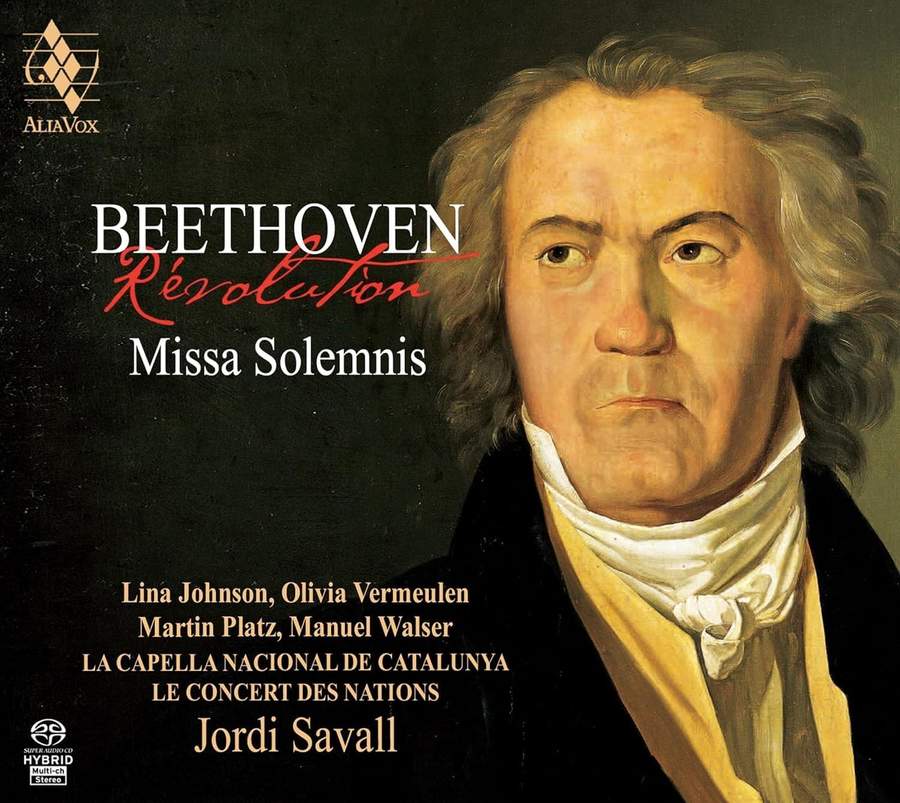BEETHOVEN Missa Solemnis (Savall)
View record and artist detailsRecord and Artist Details
Genre:
Vocal
Label: Alia Vox
Magazine Review Date: 12/2023
Media Format: Super Audio CD
Media Runtime: 76
Mastering:
DDD
Catalogue Number: AVSA9956

Tracks:
| Composition | Artist Credit |
|---|---|
| Mass in D, 'Missa Solemnis' |
Ludwig van Beethoven, Composer
(Le) Concert des Nations Jordi Savall, Conductor La Capella Nacional de Catalunya Lina Johnson, Soprano Manuel Walser, Bass Martin Platz, Tenor Olivia Vermeulen, Mezzo soprano |
Author: Peter Quantrill
Jordi Savall’s pacing of the Missa encompasses splendour as well as vigour. It is a minute or two longer than Gardiner in each movement, and he uses this extra time profitably, most of all in the Sanctus and Praeludium, handled like a grail. Pivotal transitions turn on their axis patiently, so that the outbursts of ‘Quoniam’ and ‘Osanna’ (sung by the choir, not soloists) arrive with all the requisite brilliance. I like the bubble of down-to-earth optimism as the tempo surges forwards for ‘Et homo factus est’ before lapsing into something much nearer Beethoven’s (and his contemporaries’) operatic idiom for the ‘Crucifixus’. ‘Et resurrexit’ rather jerks into action, though the overall tempo scheme for the movement is perfectly coherent, and takes in a plausible gabbling of those doctrinal elements that reportedly discomfited the composer.
The recording takes in the piece from a fair perspective without obvious highlighting, leaning in to the spacious (five-second) acoustic of the same Catalan church used to record the nine symphonies. The advantage of this approach is that the balancing of forces is obviously Savall’s work and not the producer’s. The drawback is an occasional lack of immediacy (rather than clarity) to contrapuntal lines. Leading entries by flutes and mezzos, for example, come off second or third best in an unequal struggle against subsidiary brass punctuation and amid the general clamour of exaltation.
Vibrato and coloration of voices, solo and choral, are especially well matched with each other and with the instrumental resources. A 36-strong choir more than hold their own against a 47-strong band. At every turn, voices and instruments serve the text together: tenors and lower strings planed down to chant-like homophony at ‘Et incarnatus est’; Manuel Walser and a complementary trio of bassoonists in the Agnus, probing every corner of doubt in notes and words. The whole band becomes an organ during the Praeludium, with Savall’s direction pressing a steady foot on the swell pedal.
All these virtues combine in an exceptionally attentive account of the Agnus, dramatic and devotional by turns, which is rivalled among modern versions only by Harnoncourt’s envoi on record, my final choice for the Missa in a Collection survey (12/20). Indeed, the principal deficiency of Savall’s Beethoven project is not any of its constituent elements but that the Missa marks its conclusion where Fidelio would have made a logical next step.
Discover the world's largest classical music catalogue with Presto Music.

Gramophone Digital Club
- Digital Edition
- Digital Archive
- Reviews Database
- Full website access
From £8.75 / month
Subscribe
Gramophone Full Club
- Print Edition
- Digital Edition
- Digital Archive
- Reviews Database
- Full website access
From £11.00 / month
Subscribe
If you are a library, university or other organisation that would be interested in an institutional subscription to Gramophone please click here for further information.




